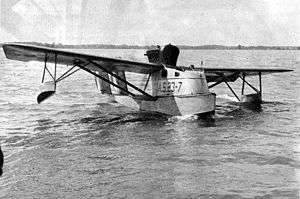Loening Model 23
| Model 23 Air Yacht, S-1 | |
|---|---|
 | |
| S-1 of the USAAS | |
| Role | Flying boat airliner |
| National origin | United States |
| Manufacturer | Loening |
| First flight | 1921 |
| Number built | 16 |
|
| |
The Loening S-1 Flying Yacht, also called the Loening Model 23, was an early light monoplane flying boat designed in the United States by Grover Loening in the early 1920s.[1] The aircraft won the 1921 Collier Trophy.
Design and development
It was a high-wing, strut-braced monoplane with the engine mounted pusher-fashion in a nacelle atop the wing. The cabin was semi-enclosed, featuring side windows but no roof, and was located immediately ahead of the wing. Twin tails were fitted, carrying a common stabiliser in a high position. The construction was unusual, in that rather than the flying boat hull being integral with the fuselage, the Model 23's hull was a large, separate pontoon mounted directly underneath a fuselage that was a separate structure.[2] This was intended to combine the safety of a floatplane design with the low parasitic drag of a conventional flying boat[2] Grover Loening was awarded the 1921 Aero Club of America Trophy for the design.[3] The fuel tank was located under the rear passenger seat.[4] The prototype was tested with a new roll-control mechanism to replace ailerons using a small leading edge that extended and retracted outboard of the wing tips.[5]
Operational history
The S-1 was the second seaplane in monoplane configuration ever to go into production.[6] It was one of the fastest seaplanes in production in 1921.[7] The S-1 set a world seaplane record of 141 mph (227 km/h) in 1921 winning the Collier trophy for the year.[8] An S-1 set a world record for altitude with four passengers flying to a height of 19,500 ft (5,944 m) over Long Island, New York in August 1921.[9]
Three of the Air Yachts were purchased by the New York-Newport Air Service,[10][11] and nine by the United States Army Air Service which operated them under the designation S-1.[10]
On a test-flight on 16 August 1921, an Air Yacht piloted by David McCullock reached an altitude of 19,500 ft (5,900 m) carrying three passengers (Grover Loening, Leroy Grumman, and Ladislas d'Orcy) in what was believed to be a record at the time.[2] On 7 November 1924, Victor E. Bertrandias set a world airspeed record for a seaplane over a 1000-km course, with a speed of 103 mph (164 km/h) in an Army S-1.[12]
Variants
- S-1
- Nine delivered to the United States Army
- Model 23
- Three delivered to New York-Newport Air Service and flown until 1923.[6][13]
- Type 23
- One custom Type 23 was ordered by Vincent Astor, and a second 400 hp (298 kW) Curtiss powered variant was also ordered.[14]
- Custom 300 hp
- Wright Aeronautical ordered a 300 hp (224 kW) Wright powered variant for a corporate aircraft named "Wilbur Wright".[15]
Operators
- New York-Newport Air Service
- United States Army Air Service (Nine with the military designation S-1)
Specifications (S-1)

Data from American Flying Boats and Amphibious Aircraft: An Illustrated History;[16]
General characteristics
- Crew: 1
- Capacity: 4
- Length: 30 ft (9.1 m)
- Wingspan: 45 ft (14 m)
- Height: 8 ft (2.4 m)
- Wing area: 330 sq ft (31 m2)
- Empty weight: 2,200 lb (998 kg)
- Gross weight: 3,550 lb (1,610 kg)
- Powerplant: 1 × Liberty L-12 , 400 hp (300 kW)
- Propellers: 4-bladed Hartzell
Performance
- Maximum speed: 123 kn; 227 km/h (141 mph)
- Cruise speed: 96 kn; 177 km/h (110 mph)
- Service ceiling: 19,500 ft (5,900 m)
- Rate of climb: 950 ft/min (4.8 m/s)
- Time to altitude: 10 mins. to 9,500ft.
- Wing loading: 10.7 lb/sq ft (52 kg/m2)
- Power/mass: 8.9lbs/hp
See also
- Aircraft of comparable role, configuration and era
References
- Notes
- ↑ Taylor 1989, 609
- 1 2 3 "The Loening Model 23 Flying Boat"
- ↑ Collier 1920-1929 winners
- ↑ "The Loening Claim for the Collier Trophy." Aviation, January 30, 1922.
- ↑ "Loening tests new type of flight control for airplanes." Automotive Industries, December 14, 1922.
- 1 2 Johnson 2009
- ↑ Aviation, February 20, 1922, p. 234.
- ↑ "The Founding Father." Flying Magazine, August 1976, p. 76.
- ↑ Aviation, January 2, 1922, p. 8.
- 1 2 Taylor 1989, 610
- ↑ "Newport-New York Air Service Ready
- ↑ FAI Record File
- ↑ Stoff 2010, p. 26.
- ↑ Flight 3 April 1922, p. 392.
- ↑ Nicolaou 1998
- ↑ Flight October 27, 1921, p. 699 et seq.
- Bibliography
- "The Loening Model 23 Flying Boat". Flight: 699–701. 27 October 1921. Retrieved 2008-10-15.
- Taylor, Michael J. H. (1989). Jane's Encyclopedia of Aviation. London: Studio Editions.
- "Collier 1920-1929 Winners". National Aeronautic Association website. Retrieved 2008-10-15.
- "New York-Newport Air Service Ready". New York Times. 26 March 1923. p. 30. Retrieved 2008-10-15.
- "Record File". Fédération Aéronautique Internationale website. Retrieved 2008-10-15.
- Johnson, E.R. American Flying Boats and Amphibious Aircraft: An Illustrated History. Jefferson, North Carolina: McFarland, 2009. ISBN 978-0-7864-3974-4.
- Nicolaou, Stéphane. Flying Boats & Seaplanes: A History from 1905. St. Paul, Minnesota: MBI, 1998. ISBN 978-0-7603-0621-5.
- Stoff, Joshua. Long Island Aircraft Manufacturers (Images of Aviation). Mount Pleasant, South Carolina: Arcadia Publishing, 2010. ISBN 978-0-7385-7336-6.
External links
| Wikimedia Commons has media related to Loening Model 23. |